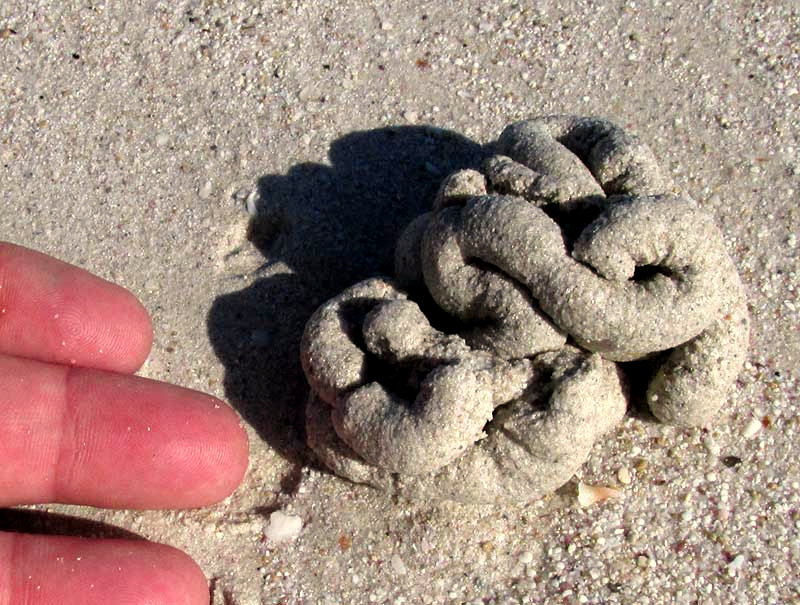Excerpts from Jim Conrad's
Naturalist Newsletter

from the February 15, 2015 Newsletter issued from Río Lagartos, on the Yucatan Peninsula's northern coast (~N21.60°, ~W88.16°), Yucatán state, MÉXICO
LUGWORM CASTINGS
At low tide along the Gulf of Mexico beach, little piles looking suspiciously like freshly deposited mammal poop were scattered here and there on wet sand that's normally submerged. You can see such a pile above.
Since the pile is shaped like a much smaller earthworm casting, I thought there might be a hole beneath the heap formed by a big worm who'd extruded the material from below. I nudged the pile but it had so little structural integrity that instead of being pushed to the side or lifted up, it simply smeared, exactly as if it were composed of nothing but wet sand.
By doing a Google image search on the keywords "worm beach sand castings," a page of image thumbnails was summoned from cyberspace. Some images similar to ours were labeled as lugworm castings, and that opened the door to an hour or so of learning about lugworms.
The best I can tell, here on the Yucatan's northern coast we have two lugworm species large enough to produce such heaps. One of them, Arenicola cristata, defecates sand in flat sheets, not as coiled heaps like ours. The other lugworm species, ARENICOLA BRASILIENSIS, produces coiled castings like ours. It's a clumsy way to identify a species, but from what can be found on the Internet, Arenicola brasiliensis seems to be the only creature capable of depositing such castings on wet beach sand in our area. Arenicola brasiliensis, which doesn't have a good English name, is broadly distributed worldwide, especially in warmer marine waters, occupying sand and mud in low intertidal zones.
Arenicola brasiliensis digs a J- or L-shaped burrow and orients itself so that its sand-depositing rear end is close to the surface. The head end stays well below the surface at the bottom of the J, where it ingests sand. As sand passes into the lugworm, a closed, funnel-shaped depression forms on the sand's surface above the head. Hopefully the sand contains enough organic matter to serve as food to keep the worm alive. The gut-processed sand is then defecated at the sand's surface, forming a casting like what's shown in our photo. It's hard to believe that the sand where I found this casting contains much organic matter, and in fact only a few castings were seen. Pictures on the Internet show certain beaches littered with vast numbers of lugworm castings, though the lugworms depositing them were of a different species.
Lugworm sex is about as impersonal as can be imagined. The individuals concerned stay in their borrows, never coming in physical contact with one another. Males periodically issue sperm into the water outside their burrows, the water carries the sperm to burrows of receptive females, and the fertilized females produce larvae who after a short period of development leave the mother's burrow to be transported by water currents to new areas.
As lugworms burrow in the sand they oxygenate it -- a process known as "bioturbation." They are preyed upon by a wide variety of animals such as birds. If a lugworm's rear end is nipped off by a hungry bird, it can be regrown, as with some lizard species.
Taxonomically, lugworms are segmented worms, or annelids, of the special kind known as polychaetes, or bristle worms. We've profiled several polychaete species before, all of which lived in various kinds of calcareous tubes, not burrows in sand. You can review those other polychaetes on our Worms Page at www.backyardnature.net/n/worms.htm.
I didn't dig into the sand to expose the lugworm to be photographed, simply because I didn't want to ruin the creature's day.